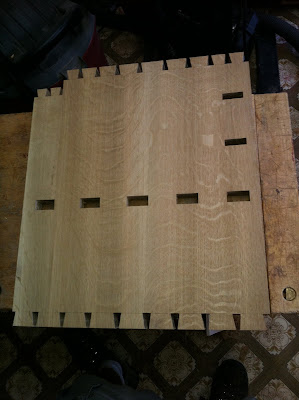
After years of cutting the pins first, I have switched over (perhaps for life) to cutting tails first for the simple reason that I can cut both sets of tails at the same time: half the layout time, half the sawing time ... tough to beat.

I had also been a longtime practitioner of chopping the waste between pins and tails by chisel. My current belief is that this practice is only more efficient when chopping dovetails in softwoods or in very thin hardwoods (i.e. 3/8" oak drawer sides).

Today I found that the fastest way to remove waste (from 1" thick white oak) was to remove the bulk of the waste with 2 passes from a coping saw followed by a single chisel chop on each side of the waste. I am struggling to find a good system for ensuring that the base of the dovetail waste corresponds closely to my 1/2" dovetail chisel. Next time I am going to layout the waste to be 1 or 2mm wider than my chisel. Trying to have an exact 1/2" base for the waste resulted in too many of the waste sections being narrower than 1/2" and requiring me to downsize to a 1/4" dovetail chisel --> twice as much chopping

Today I also completed the through-mortises on the carcass sides. After dadoing the interior of the carcasses to house the drawer runners, I removed the bulk of the waste for the through-mortises by drilling with with forstner bits and then chopping them square. This is the first time that I've used a through-mortise for a drawer runner, but I think it may become a staple in projects to come. It adds a lot of rigidity to the carcass and doesn't add a lot of work
Below is a view of the interior which have been dadoed out for the drawer runners. The rear mortises only go a 1/2" deep because all of my maple was only 24" long and I didn't want to buy more.

It's looking like rain through the end of the week, so I may have this assembled by Monday. All the pins and through-tenons have been scribed and are just awaiting cutting. I really like the way the sides look at the moment: very much like some kind of chess piece.
 While this workstation is a form of packing (it's how my tools will travel to California), it has replaced all the time and energy I should have been spending packing up my apartment. Last night at dinner, my friend Andrea, a tutor, informed me that I was resembling a very productive version of some of her gamer students who can't get their homework because they spent all night playing Call of Duty.
While this workstation is a form of packing (it's how my tools will travel to California), it has replaced all the time and energy I should have been spending packing up my apartment. Last night at dinner, my friend Andrea, a tutor, informed me that I was resembling a very productive version of some of her gamer students who can't get their homework because they spent all night playing Call of Duty. So after letting Andrea's comment sink in I awoke this morning at 5am, and came to the shop intent on fitting the drawers so I could take a one-week sabattical from this project. Well, the drawers were fit in record time, and I feel good walking away for a little while to wrap up my remaining packing.
So after letting Andrea's comment sink in I awoke this morning at 5am, and came to the shop intent on fitting the drawers so I could take a one-week sabattical from this project. Well, the drawers were fit in record time, and I feel good walking away for a little while to wrap up my remaining packing. Oh yes and the weight looks like it will be approaching 125lbs. So the handles, while beautiful, will only be useful when all of the drawers are removed.
Oh yes and the weight looks like it will be approaching 125lbs. So the handles, while beautiful, will only be useful when all of the drawers are removed.































